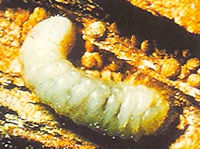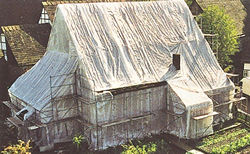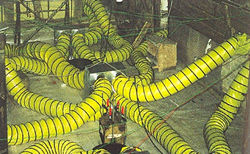The Eradication of Insect Pests in Buildings
Paul Leary
 |
| Deathwatch beetle populations flourish where there is water penetration and decline when the building is dry and well maintained. By the time a deathwatch colony is well established the beetles no longer lay eggs on the surface. Female beetles go back into the timber to deposit their offspring, whereupon the eggs and young larvae are inaccessible to insecticides. |
Insect pests are responsible for the continual, often undetected, erosion of our cultural heritage and the undermining of the structural integrity of many of our significant architectural masterpieces. Most of the insects responsible for damage to buildings, their components and furnishings are beetles, although a number of other groups contribute to the problem.
The four key factors governing the survival of beetles and other insects in buildings are: food, harbourage, warmth and water (moisture /humidity).
THE INSECT PESTS' ENVIRONMENT
Many insect pests have evolved from the forest floor or similar habitat, where dead and decaying timber and other vegetation is naturally available. In order to survive and procreate, wood-boring insects in buildings require a comparable dark, damp or humid environment with little ventilation and ambient temperature. By keeping timber out of such environments, or by improving the environmental conditions in which it exists, it can be saved from these destructive organisms.
Food and harbourage
Timber,
like most organic materials, is a good source of energy and a readily
available supply of food for many insects and in most ancient and historic
buildings the material features as a major component of their structure,
fittings and furnishings. Other food sources include natural textiles
and carpets, leather and many other organic materials.
Many species of insects are introduced through birds' nests. Dead rodents, birds and other non-pest insects such as flies and wasps, debris in disused chimneys, heating ducts and other unventilated spaces will all provide an attractive source of food and harbourage for serious insect pests such as fur and carpet beetles. These insects can then move on to destroy carpets, furniture, curtains and clothing. The development of bacteria and moulds in bird nests and other detritus can also encourage mould-feeding insects such as silverfish, plaster beetles and booklice.
Warmth and water (moisture/humidity)
Insects thrive in warm,
moist conditions. Temperatures of 20 degrees C and above will encourage
insect breeding. Furniture beetle ('woodworm'), for example, has declined
in recent years due to the increased use of central heating, which reduces
relative humidity (RH), since it will only successfully complete its life
cycle when wood is in an environment above 60 per cent RH. It is usually
only found infesting wood in damp basements, attics or in outbuildings
and in objects that have been stored at ambient conditions. Sources of
dampness, such as condensation, poor damp-proofing or leaks from gutters
or water pipes must be checked and remedied.
IDENTIFICATION AND MONITORING OF INSECT PESTS
Many different insects, with wide-ranging habits and food preferences, are found in buildings and it is important to identify those which are pests and cause damage to the building fabric or structure and those which do not. Independent advice by specialists is advisable, if not essential, in order that unnecessary treatment can be avoided.
Trapping insects using, for example, UV, pheromone and blunder traps to attract them to sticky pads, can help to control insect populations and provides an excellent means of monitoring activity and species.
WOODBORING INSECTS
Common
furniture beetle
Beetles have a life
cycle consisting of four stages - egg, larva (which causes all the damage),
pupa and adult beetle. The eggs of the common furniture beetle (Anobium
punctatum) are laid in end grain or in existing flight holes. They
hatch in four to five weeks and the new larvae bore directly into the
wood. The larvae feed and grow within the wood creating a network of tunnels
closely packed with frass (fine dust). When fully grown, the larva excavates
a small chamber and pupates, producing a beetle after six to eight weeks.
The beetle then bores through a thin layer of wood producing the characteristic
emergence holes generally in early summer. The life cycle usually takes
a minimum of three years within buildings. Attack is normally confined
to the sapwood of softwoods and hardwoods, but may occur in the heartwood
in timbers such as beech, birch and spruce, or in timbers modified by
fungal decay.
House
longhorn beetle
House longhorn beetle
(Hylotrupes bajulus) is a major cause of damage to softwood building
timbers throughout central and southern Europe. In the UK, significant
damage is confined in the main to roof timbers and distribution is concentrated
in a particular area to the south west of London.
The beetle attacks the sapwood of seasoned softwood timber and can completely disintegrate the sapwood under an intact outer veneer. In older buildings this may be of little consequence since the roof timbers are large and a high proportion of the cross-section is heartwood, which is immune from attack.
Newer buildings, in particular domestic dwellings built after the First World War and up to the present day, have smaller timbers which often contain a large proportion of sapwood. This provides the potential for roof collapse if the timbers become seriously infested with house longhorn beetle.
House longhorn is a large (12-15mm) beetle with long antennae. The larvae bore mainly in sapwood, creating tunnels of increasing size and taking three to five years to complete development. The adults require temperatures of at least 25 degrees C in the summer months. Furniture and other objects recently imported into the UK may carry larvae inside which can be heard scratching the wood as they eat.
Deathwatch
beetle
In the British Isles,
deathwatch beetle (Xestobium rufovillosum) infestations occur most
commonly in oak, probably because this wood used to be extensively employed
in construction, but infestation can also occur in elm, walnut, chestnut,
elder and beech. The life cycle is similar to that of the common furniture
beetle but can take many years to complete. When the larva is fully grown,
it pupates and metamorphoses into the adult beetle, which does not emerge
until the spring of the following year.
In old buildings, severe damage can be caused under favourable environmental conditions. Softwoods are occasionally infested where they are in close proximity to damp infested hardwood. Infestation is confined to fungally-decayed or damp-affected timbers. Many existing cases probably arose from the reuse of infested timber from demolished buildings or from the use of unseasoned timbers in their construction. Attack is not confined to the sapwood and often the heartwood is entirely consumed, causing severe structural damage.
Many beetles do not bite their own exit holes from the wood. Beetles will emerge from any available hole or fissure. This means firstly that the beetle does not take treated timber into its mouth, and secondly that a lack of fresh holes does not mean that a beetle infestation is extinct.
METHODS OF INSECT ERADICATION
Chemical
control methods
The general basis of
all chemical methods, whether based on synthetic or naturally derived
materials, is that they are poisons. Not only are they poisonous to insects,
they are nearly always poisonous to other animals including man. A balance
must be maintained between the toxicity of pesticides to the target insects
and the risk to people, animals, objects and the environment.
Liquid insecticides applied excessively to structural timber in the form of sprays and pastes, may kill emerging beetle adults and any larvae and pupae near the surface of the wood. However, they are unlikely to entirely eradicate extensive and deep-seated infestations in timbers with a large cross section since they are inaccessible, leaving some of the most vulnerable timbers at risk of continuing destruction.
'Free' surveys offered by timber decay treatment companies tend to err on the side of caution and operators may liberally apply toxic chemicals whether or not the infestation is still active.
During the past few years, research has brought about universal condemnation of chemical pest control methods. Governmental and environmental agencies are actively legislating against the use of endocrine disrupting chemicals, concerned about the adverse long-term effects on immune systems of substances such as lindane, dichlorvos and DDT, once common constituents of many pesticides and insecticides, and now water-based micro-emulsions are becoming more acceptable.
Fumigation
This is a term which
is frequently used for almost any insecticide treatment but which should
only be applied to the use of fumigant gases.
Objects may be fumigated under gas-proof sheets or in specially built or modified chambers. In some cases whole buildings and their contents can be fumigated by sealing all doors, windows and other apertures with special tape or by covering the entire building with gas-proof sheets.
 |
 |
| Treating a timber-framed building using the Thermo Lignum system: (top) prior to enclosing the structure or component with insulating materials, up to 100 temperature and humidity sensors are positioned at predetermined locations within the treatment area. The process is then applied by passing warm humidified air into the enclosure via insulated flexible hoses (bottom). A continuous flow of data is received via remote control from the sensors, enabling the operator to accurately monitor and adjust accordingly, the RH and temperature within the enclosed atmosphere. |
The principle of fumigation is that the gas is introduced into the air space around objects for a period long enough for the gas to penetrate the material being fumigated and to poison the insects. The effects of fumigant gases and consequent residues on objects do give cause for concern. After exposure, extensive venting-off periods are needed in order to disperse traces of gas that have been adsorbed by the fumigated goods. Some of the gases used may also adversely affect the historic fabric itself.
All successful fumigation relies on understanding the properties and limitations of the fumigant gas which is being used. It is particularly important that the complex relationship between the concentration of the gas and the time of exposure is understood.
The three most commonly used fumigants are methyl bromide, phosphine and ethylene oxide. Because they are so toxic, the use of fumigants is restricted in most countries by complex safety regulations. Methyl bromide, the versatile chemical fumigant, has recently been classified as an ozone-depleting compound and with a phase-out date for the developed world set for 2005 and the first step, a 25 per cent reduction already imposed, scientists and researchers are anxiously searching for alternatives.
Carbon
dioxide or nitrogen
A non-toxic alternative
is to displace the air surrounding the material affected, with an inert
gas, so that the insects die from a lack of oxygen. Carbon dioxide, and
nitrogen which is virtually inert, have been successfully used for this
purpose. However it is a slow and expensive process and is really only
necessary for the treatment of very delicate, sensitive or fragile materials
and is largely impractical for use in buildings.
The Thermo Lignum 'Warmair' system has also been used successfully in conjunction with nitrogen in a mobile scaled chamber (marketed by.Thermo Lignum as the 'Noxia' technique) for the treatment of small objects such as framed 'Old Master' paintings, where woodworm has infested the stretcher frame. This is much faster than using nitrogen in isolation, reducing treatment times from 28 days at 25 degrees C down to eight to ten days at 36 degrees C.
HEAT TREATMENT WITH CONTROLLED HUMIDITY
The key to a chemical and gas-free alternative lies in the fact that the majority of insects at any of the various stages of their life cycle will die if they are subjected to temperatures between 50-55 degrees C for an extended period. It is this biological fact that lies behind the Thermo Lignum 'Warmair' system.
The principle behind using heat to kill insects in objects, was that by accurately controlling the relative humidity (RH) of the atmosphere around them, organic materials could be prevented from dehydrating during the heating cycle. In this way the resultant splitting, twisting and warping of wood, for example, would be eliminated.
In addition to extensive trials on a range of timbers, the method was tested successfully on organic and synthetic adhesives, veneers, paintings, leather and skins, ethnographic and natural history specimens, herbaria, paper and a wide spectrum of textiles.
Building
applications
For the treatment of
insect-infested structural or architectural timbers in situ, this process
has been adapted for use with portable gas fired heating equipment. In
order to eradicate the beetle population it is essential to penetrate
to the core of the infested timbers. The Thermo, Lignum Warmair' process
is designed to do this by using strictly controlled, warm humidified air.
Initially, where necessary, thermally resistant insulating materials are used to isolate the areas for treatment. In each treatment location core temperature sensors and humidity sensors are installed. The core temperature sensors are placed in the thermally least favourable positions by drilling holes of 4mm in diameter into the core of the structural elements that are to be monitored. The core temperature sensors are inserted in these holes and connected by cable to a radio monitoring system that transmits all temperature and humidity data to a data collection system, allowing the operator to adjust the equipment output accordingly.
Based upon the volume of the space to be heated and the thermal properties of the building materials, calculations are made to determine the number of heaters required. Each heater is powered by propane gas and has an energy output of 140kW, an air output of 4,000m³/hr and is equipped with a high-pressure device for air humidification.
The heated and humidified air is inducted into the treatment zone via a system of 300/400mm diameter hoses and distributed via a manifold air distribution system. The air distribution is optimised to provide all rooms and areas with balanced airflow. Humidification of the air prevents any drying out effect and thus any shrinkage in the structural timber elements. The input temperature of each machine, which is limited to a maximum of 80°C, is similarly recorded via the data collection system.
The temperature is then slowly raised, whilst maintaining a maximum differential between surface and timber core temperatures of 20°C. Once the insect kill temperature of 55°C has been achieved (with all installed core temperature sensors having reached this benchmark) a holding phase of three hours commences. It is in this phase that the actual eradication of the entire insect pest colony (egg, larva, pupa, and adult) takes place through denaturing of the protein in the insects’ cells. After this period the temperatures are slowly brought down to 40°C and the heaters are switched off. The entire process can take between 24 and 72 hours dependent upon prevailing weather and the fabric of the building.
The Thermo Lignum mobile 'warmer' chamber
Where many items of furniture and smaller fittings in a house need to be treated, the use of the mobile ‘Warmair’ chamber provides the ideal means for delivering environmentally benign treatments which are 100 per cent effective against all infesting insects, at any stage of their lifecycle, and in any organic material.
RECENT RESEARCH
In 1993 English Heritage decided to initiate an international research programme in order to study the behaviour of deathwatch beetles in buildings, and to find out why spray treatments did not work. This research project continued for three years, and it had the advantage of analytical techniques far beyond those available to earlier researchers.
This recently acquired information enabled English Heritage to suggest a new treatment protocol.
- Spray treatments do not work.
- Locate active infestation by finding live or dead beetles.
- If there is active infestation then check for water penetration.
- Locate active infestation and then apply localised deep penetrating treatments.
No evidence has been found to support the supposition that chemical treatments will eradicate a deathwatch beetle infestation, although they might help to control it. Most of the timbers containing active infestation are likely to be inaccessible.
Before undertaking any treatment, bear in mind the importance of primary control methods, including the introduction of good ventilation to reduce humidity levels, simple housekeeping measures to reduce detritus, and thorough surveying and monitoring. Chemical treatment is often ineffective and can be harmful to the historic fabric as well as the health of the occupants.
~~~
Recommended Reading
- Tim Hutton, 'The Environmental Control of Timber Decay', Structural Survey, Vol 10:1, Summer 1991
- Hubertus Michels and Uwe Noldt, Monitoring of Wood Boring Insects and Attendant Pest Control Measures, Detmold, Germany, 2002
- David Pinniger, Pest Management in Museums, Archives and Historic Houses,
Archetype Press, London, 2001 - Brian Ridout, A Brief History of the Deathwatch Beetle and its Treatment. Published in Preserve, Issue 6, Spring 2002
- Brian Ridout, Timber Decay in Buildings: The Conservation Approach to Treatment, E & FN Spon, London, 2000
- Geraldine Lea, 'House Longhorn Beetle', published in Preserve Issue 6, Spring 2002



